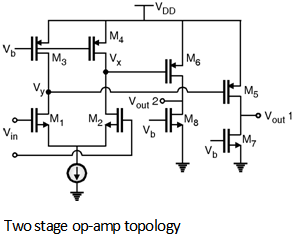Home > Analog CMOS Design > CMOS Opamp > Two Stage Op amp
Two Stage Op-amp :
In some applications the gain provided by single stage op-amps is not sufficient. In such circuits two stage op-amps are used. The first state of the op-amp provides the required large gain and second stage gives the large voltage swings. Figure below shows the simple two state op-amp circuit.

The first stage of the op-amp is a differential pair consists of transistors m1, m2, m3 and m4. The output Va and Vy are the differential output 6 which are given by,
Vx = gm2 (r02 || r04) V in and
Vy = gm1 (r01 || r03) V in
These voltages Vx and Vy are then further amplified by the 2nd stage which a is consists of the transistors m 5, m7 and m6, m8. The output voltage at the 2nd stage is given by,
Vout1 = gm5 (r05 || r07) V y and
Vout2 = gm6 (r06 || r08) V x.
\ The total gain of the op-amp is the product of the gains of the stages which is given as,
Av = g m1 g m5 (r01 || r 03) (r05 || r07)
or It can be also given as,
Av = g m2 g m6 (r02 || r 04) (r06 || r08)